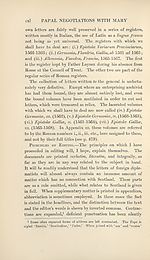Series 1 > Papal negotiations with Mary Queen of Scots during her reign in Scotland, 1561-1567
(146) Page cxli
Download files
Complete book:
Individual page:
Thumbnail gallery: Grid view | List view

INTRODUCTION
cxli
supplemented. The documents are subdivided into sections by
numerals enclosed in square brackets, which are used for all
editorial additions.
Large and small type are used to guide the reader in dis¬
tinguishing what is more important and new in the series of
despatches from translations and other subsidiary matter. As,
however, there are many distinctions in the matter of novelty
and importance, the nature of which cannot be explained by
one change of type, a more precise definition of the value of
each text is added in small type.
In translation I have aimed chiefly at strict fidelity. On
the other hand, I have not treated the texts as though they
were inspired writings or even legal formulas, where every
little turn and syllable was of importance. The originals are
as a rule simple, rapidly written letters, in which very little
turns on verbal minutice, much upon a grasp of the argument
considered as a whole. Attention has, therefore, been paid to
the flow of the narrative, English idioms are substituted for
those which are foreign, complimentary superlatives are often
reduced to positives, and elaborate and untranslatable greet¬
ings and farewells, ‘ oscula pedum,1 ‘ bascia mano,1 etc. etc. are
frequently omitted. For clearness1 sake the modern title
‘Eminence1 has been generally given to cardinals, though at
that time they were still addressed as ‘ Signoria Illustrissima.1
The readings and translations of deciphers, it will be
observed, are often uncertain. The cipher-clerks endeavoured
to shorten their labours by undue abbreviation, the cipher-
codes were not very easy to apply, and the result was frequent
confusion. Similar causes lead to a similar frequency of errors
we naturally get S.S., S.B., B.P., V.S., V.B. ‘Signoria’ (Latin ‘Dominatio’)
was the title for bishops, cardinals, etc., and might be qualified by ‘ Illustrissima,’
‘ Reverendissima,’ and ‘ Eccellentissima. ’ Hence the forms S.S., V.S., V.S.I.,
V.S.I. & R., V.S.I. molto R., D.V., D.V.I., etc., and even E.D.V.I. & R.
A priest, ‘ Paternitas,’ will be addressed as R.P., T.R.P., R.P.V., etc. In
practice all these forms are translated by ‘ you ’ and ‘ he.’
A (sometimes V) stands for ‘scudo,’ a crown (p. 264, note.)
Te
cxli
supplemented. The documents are subdivided into sections by
numerals enclosed in square brackets, which are used for all
editorial additions.
Large and small type are used to guide the reader in dis¬
tinguishing what is more important and new in the series of
despatches from translations and other subsidiary matter. As,
however, there are many distinctions in the matter of novelty
and importance, the nature of which cannot be explained by
one change of type, a more precise definition of the value of
each text is added in small type.
In translation I have aimed chiefly at strict fidelity. On
the other hand, I have not treated the texts as though they
were inspired writings or even legal formulas, where every
little turn and syllable was of importance. The originals are
as a rule simple, rapidly written letters, in which very little
turns on verbal minutice, much upon a grasp of the argument
considered as a whole. Attention has, therefore, been paid to
the flow of the narrative, English idioms are substituted for
those which are foreign, complimentary superlatives are often
reduced to positives, and elaborate and untranslatable greet¬
ings and farewells, ‘ oscula pedum,1 ‘ bascia mano,1 etc. etc. are
frequently omitted. For clearness1 sake the modern title
‘Eminence1 has been generally given to cardinals, though at
that time they were still addressed as ‘ Signoria Illustrissima.1
The readings and translations of deciphers, it will be
observed, are often uncertain. The cipher-clerks endeavoured
to shorten their labours by undue abbreviation, the cipher-
codes were not very easy to apply, and the result was frequent
confusion. Similar causes lead to a similar frequency of errors
we naturally get S.S., S.B., B.P., V.S., V.B. ‘Signoria’ (Latin ‘Dominatio’)
was the title for bishops, cardinals, etc., and might be qualified by ‘ Illustrissima,’
‘ Reverendissima,’ and ‘ Eccellentissima. ’ Hence the forms S.S., V.S., V.S.I.,
V.S.I. & R., V.S.I. molto R., D.V., D.V.I., etc., and even E.D.V.I. & R.
A priest, ‘ Paternitas,’ will be addressed as R.P., T.R.P., R.P.V., etc. In
practice all these forms are translated by ‘ you ’ and ‘ he.’
A (sometimes V) stands for ‘scudo,’ a crown (p. 264, note.)
Te
Set display mode to:
![]() Universal Viewer |
Universal Viewer | ![]() Mirador |
Large image | Transcription
Mirador |
Large image | Transcription
Images and transcriptions on this page, including medium image downloads, may be used under the Creative Commons Attribution 4.0 International Licence unless otherwise stated. ![]()
| Scottish History Society volumes > Series 1 > Papal negotiations with Mary Queen of Scots during her reign in Scotland, 1561-1567 > (146) Page cxli |
|---|
| Permanent URL | https://digital.nls.uk/126972885 |
|---|
| Attribution and copyright: |
|
|---|
| Description | Over 180 volumes, published by the Scottish History Society, containing original sources on Scotland's history and people. With a wide range of subjects, the books collectively cover all periods from the 12th to 20th centuries, and reflect changing trends in Scottish history. Sources are accompanied by scholarly interpretation, references and bibliographies. Volumes are usually published annually, and more digitised volumes will be added as they become available. |
|---|


